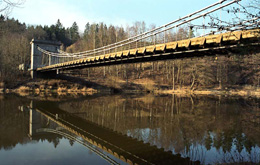
The same bridge has been over the Vltava for 112 years, now it has been over the Lužnice for 40 years
 |
The suspension chain bridge has a rich history. The contract for its construction was awarded in the 19th century to the České Budějovice company of Josef Lanna, who utilized the plans of architects Schnirch and Gassner. Entrepreneur Lanna was a successful builder of ships and mills, co-creator of the famous "koňka" from České Budějovice to Linz, and co-founder of the Kladno mines and steelworks. His company could also boast of a significant construction achievement - the Prague chain bridge of Emperor Francis I.
In May 1847, the cornerstone of the bridge was laid, and about a year later it was completed. For decades, it ruled as an important trade link crossing southern Bohemia, but eventually, it became inadequate. In 1938, an impressive, significantly higher reinforced concrete arch of the new Podolský Bridge began to rise right next to it. This was completed in 1942, but the old "chain bridge" continued to serve at least as a local road and attraction until it was threatened by the Orlík Dam project.
The bridge was saved by the fact that it was already on the list of technical monuments (since 1959), and fortunately, the state did not respond to an offer from a foreign bidder to purchase this unique structure. In 1960, the bridge's construction was dismantled into individual stones and components, which, properly numbered and stored, awaited their future fate for a long time. Ultimately, 13 locations were in play for its new spot. A condition for selection was that the bridge would not only beautify the surroundings but also continue to serve.
Finally, the landscape relief near the village of Stádlec on the Lužnice won out, where the terrain is similar to that near Podolsko. Workers had to assemble 2000 labeled granite blocks and more than a thousand steel components. The supporting structure of the bridge consists of four chains resting on two stone pylons or gates. The bridge is 157 meters long and six meters wide. In addition to pedestrians, this structure still serves cars up to two meters in width and weighing two tons.
In 2006, the Stádlecký Bridge underwent a two-month renovation, which cost about 3.5 million crowns from the region. The construction had been in a dilapidated state for years, posing a danger to tourists. Spruce beams, some up to 150 years old, were rotten, crumbling, and had gaps between them. They were replaced with specially modified oak beams, over six meters long. Craftsmen also replaced the lower part of the wooden structure and used old methods from when the bridge was originally built during the work.
There were several chain bridges in the country: in Strážnice, in Žatec, and in Loket. Perhaps the most famous was the Francis I Bridge - the predecessor to today's Legií Bridge in Prague. There are now only four bridges in the Czech Republic that are national cultural monuments. In addition to the Stádlecký Bridge, these include the Charles Bridge in Prague from 1402, the Stone Bridge in Písek, which is the oldest Czech bridge (built around 1300), and the Bechyně Bridge from 1928.
The English translation is powered by AI tool. Switch to Czech to view the original text source.
0 comments
add comment
Related articles
0
23.09.2020 | The region has started repairing the Stádlecký Bridge, the work will last for two months
0
24.05.2010 | 25 years ago, the Empire chain bridge near Stádlec was reopened
0
30.03.2008 | Czech Republic is a land of monuments, increasingly attracting interest in technical
0
25.04.2007 | Mosty in the Czech Republic: the most famous is Charles Bridge, the oldest is in Písek












